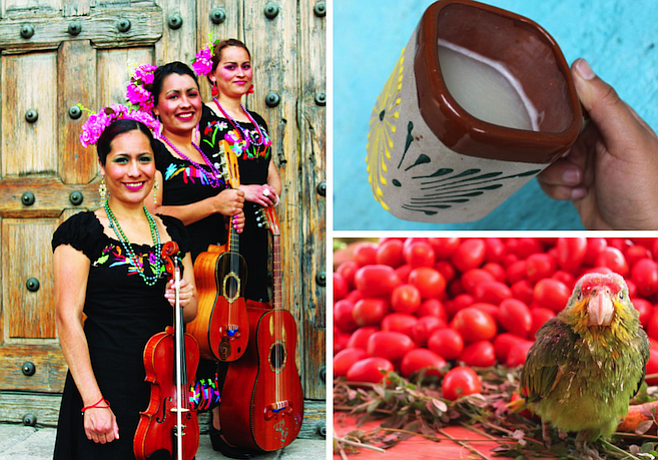 Facebook
Facebook
 X
X
 Instagram
Instagram
 TikTok
TikTok
 Youtube
Youtube

Hidden in Mexico City's northern outskirts is the town of Tepotzotlán. Despite how close they are to one another, Tepotzotlán is about a two-hour drive from Mexico City due to havoc traffic.
When I arrived, I had to get my hands on some tasty pulque, a traditional alcoholic drink that's made by fermenting nectar from the maguey plant. For an inexpensive price, local brew houses around the neighborhood sell what the Aztecs called “the drink of the gods.” With a liter of pulque successfully procured, we enjoyed the drink on a rooftop overlooking most of Mexico City.

I learned an interesting fact about the name of the small town. The náhuatl word Tepotzotlán means "aside the hunchback," because of a hill that resembles a hunchback (left). Rumor has it that thieves built an underground tunnel that ran from the hill to the San Francisco Javier church to steal gold. Others say they have seen lights floating around the hill and suddenly disappearing. The town itself is categorized by the country's tourism board as a "Magical Town of Mexico", which might lend a little more credence to the legends.
My second day here, I decided to go into the city. I’ve never been a fan of big cities – but the Zocalo is the reason why I love Mexico City. Authentic artisan crafts, Aztec dancers doing herbal smuging, signs of what used to be Aztec structures, it all made me feel at home and proud of my roots.
I felt the same way when I climbed the 365 steps of the Pyramid of the Sun in Teotihuacan, and roamed around Frida Khalo’s Blue House in Coyacan.
Returning from the city to Tepotzotlán’s main square, I decided to enjoy a michelada, a 32-ounce draft beer rimmed with tamarind and chili powder. As I sat and enjoyed my drink, I got to reflecting on my adventures in Mexico City and Tepotzotlán, and on the special aura of these places.
The last hours in Tepotzotlán were probably the most magical. My day of departure arose. I had plans to catch a 7 p.m. bus that would take me to the western city of Zihuatanejo to visit more family. Noon came up, and fate stepped in. Earlier in my trip, I had met a talented young woman who sang and played huapango – traditional Mexican folk music – with her two sisters. She gave me the opportunity to photo shoot their band, Las Palomitas Serranas, in Tepotzotlán’s main square and the San Francisco Javier church.
As they stood and posed in their traditional embroidered Mexican dress and instruments, I realized that the trip to this magical town had come at an opportune time. Riding back into Mexico City, I knew this would not be my last visit here.


Hidden in Mexico City's northern outskirts is the town of Tepotzotlán. Despite how close they are to one another, Tepotzotlán is about a two-hour drive from Mexico City due to havoc traffic.
When I arrived, I had to get my hands on some tasty pulque, a traditional alcoholic drink that's made by fermenting nectar from the maguey plant. For an inexpensive price, local brew houses around the neighborhood sell what the Aztecs called “the drink of the gods.” With a liter of pulque successfully procured, we enjoyed the drink on a rooftop overlooking most of Mexico City.

I learned an interesting fact about the name of the small town. The náhuatl word Tepotzotlán means "aside the hunchback," because of a hill that resembles a hunchback (left). Rumor has it that thieves built an underground tunnel that ran from the hill to the San Francisco Javier church to steal gold. Others say they have seen lights floating around the hill and suddenly disappearing. The town itself is categorized by the country's tourism board as a "Magical Town of Mexico", which might lend a little more credence to the legends.
My second day here, I decided to go into the city. I’ve never been a fan of big cities – but the Zocalo is the reason why I love Mexico City. Authentic artisan crafts, Aztec dancers doing herbal smuging, signs of what used to be Aztec structures, it all made me feel at home and proud of my roots.
I felt the same way when I climbed the 365 steps of the Pyramid of the Sun in Teotihuacan, and roamed around Frida Khalo’s Blue House in Coyacan.
Returning from the city to Tepotzotlán’s main square, I decided to enjoy a michelada, a 32-ounce draft beer rimmed with tamarind and chili powder. As I sat and enjoyed my drink, I got to reflecting on my adventures in Mexico City and Tepotzotlán, and on the special aura of these places.
The last hours in Tepotzotlán were probably the most magical. My day of departure arose. I had plans to catch a 7 p.m. bus that would take me to the western city of Zihuatanejo to visit more family. Noon came up, and fate stepped in. Earlier in my trip, I had met a talented young woman who sang and played huapango – traditional Mexican folk music – with her two sisters. She gave me the opportunity to photo shoot their band, Las Palomitas Serranas, in Tepotzotlán’s main square and the San Francisco Javier church.
As they stood and posed in their traditional embroidered Mexican dress and instruments, I realized that the trip to this magical town had come at an opportune time. Riding back into Mexico City, I knew this would not be my last visit here.
Comments